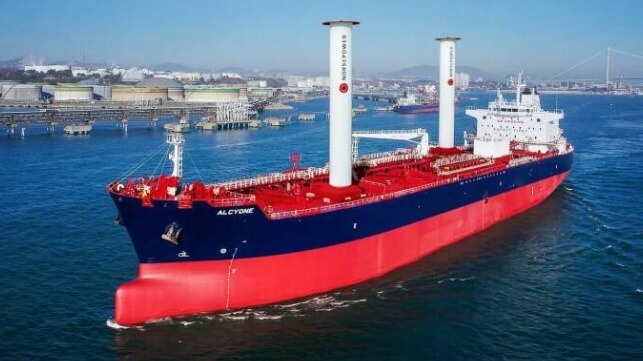French MR Tanker to be Retrofitted with Rotor Sails

Interest continues to grow in the forms of wind power-assisted propulsion as an available technology to help shipping companies and shippers meet the challenges of improving their performance as it relates to meeting the regulatory goals to reduce emissions. In the latest step, another shipping company, France’s Socatra has decided to retrofit one of its tankers with rotor technology from Norsepower.
“As the oil industry is moving towards a low-carbon future, it is everyone’s responsibility to put forward tangible and economically viable solutions,” said Laurent Bozzoni, CEO of Socatra. “The Norsepower Rotor Sail is widely recognized as a proven solution for sea-going vessels, and we believe that our MR tanker Alcyone will benefit from significant efficiency gains and help us reduce our CO2 emissions.”
The tanker is a Medium Range (MR) tanker, the Alcyone (50,000 dwt), which was built in 2022 by Hyundai Mipo Dockyard in South Korea. The vessel currently has a fairly standard power plant consisting of a two-stroke MAN-B&W diesel engine as well as three diesel generators. The 600-foot tanker has a cargo capacity of over 53,000 cubic meters.
The agreement calls for the installation of two rotors aboard a vessel. Each will stand approximately 115 feet and will have a 16-foot diameter. They will be built at Norsepower’s new production hub in China with delivery in December 2023. Installation of the rotors is scheduled for either Q4 2023 or Q1 2024.
“The Norsepower Rotor Sail is particularly well-suited to tankers, with a strong track record of proven performance,” said Tuomas Riski, CEO of Norsepower. “This is why we are confident that we can achieve at least eight percent fuel consumption saving, based on existing data and projections, ensuring Socatra leads the way for more planet-positive operations for others in the oil industry. As our first client in the French market, it is a testament to the versatility and adaptability of our technology.”
Norsepower calculates that the average fuel and carbon emission reductions will be eight percent for the ship as it transits between South Korea and French Polynesia, with the potential for further savings using voyage optimization reaching up to 2,000 tons of CO2 per annum.
The vessel operates under a long-term charter to TotalEnergies. The companies point out that the rotors make up a part of a holistic approach to decarbonization and combining clean technology solutions enables key progress towards emissions reduction goals, minimizing fuel costs, enabling carbon regulatory compliance, and improving IMO Carbon Intensity Indicator (CII) ratings.
Norsepower was founded a decade ago seeking to commercialize a nearly century-old technology, the Flettner rotor. The modern system creates lift with the Magnus effect by turning the rotor with the ship's low-voltage network. According to the company, the Rotor Sail technology is around ten times more efficient than a conventional sail, because more lift is produced with a much smaller sail area. Since then the technology has been installed on a Maersk tanker, North Sea passenger ferries, a Chinese bulker operating for Vale, and North Sea Ro-Ros while also being studied for various near-term applications on a variety of ships.
